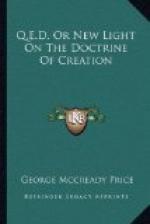[Footnote 29: Encyclopaedia Britannica, Vol. XVIII, p. 119.]
IV
Vanished at last are the old theories of gradual changes in species perpetuated and accumulated by natural selection until at last wholly new forms have in this way been produced. True variations are now seen to be confined within well-marked and rather narrow limits, within which ordinary variations may occur, perhaps induced by environment. These fluctuating variations grade off into one another on all sides, and their differences can be plotted on a frequency curve; but the very important thing for us to remember is that these fluctuating variations cannot be transmitted. Beyond these fluctuating variations come the unit characters or factors, which are distinct from each other, or “discontinuous,” to use the technical term, and which therefore cannot be plotted on a frequency curve. These factors are not modified in the least by the environment, and their peculiarities are faithfully transmitted in heredity with all the precision of chemical law. But even these factors are all within the bounds of the species. There is not a shred of scientific evidence that either natural or artificial devices have originated a single genetic factor that was not all the time potentially latent in the ancestry, capable of being produced at will by the proper combination.
It is a universal law of living things that all forms left to themselves tend to degenerate. The necessity for continuous artificial selection in the sugar beet, in Sea Island cotton, in corn, in Jersey and Holstein cattle, in trotting horses, proves this universal tendency to degenerate.[30] Natural selection in a somewhat similar way tends to postpone this degeneracy by killing off the “unfit,” but selection either artificial or natural cannot originate anything new, and its results are here displayed merely among the small fluctuating variations mentioned above. Even among the real genetic factors it may show itself by allowing some to survive alone; but as no combination of diverse factors can originate anything really new, its field for operation among these factors is extremely limited. Among species also it is operative, killing off some and allowing others to survive. But neither among fluctuations, among factors, nor yet among species can selection originate anything new.
[Footnote 30: The following represents the consensus of scientific opinion regarding the lessons to be drawn from the phenomena of our improved races of domesticated plants and animals:
“One need not be a pessimist to assert the actual evidence thus far obtained indicates that the supposed progress made in the improvement of domesticated animals and plants is nothing more than the sorting out of pure lines, and thus represents no advancement.”—Prof. L.B. Walton, Science, April 3, 1914.]




